Galapagos Sustainable Tourism is crucial for preserving this unique ecosystem while allowing travelers to experience its wonders, and SIXT.VN is committed to making your trip both unforgettable and eco-friendly. By choosing sustainable practices, we can minimize the impact on the environment and support local communities. Let’s explore how sustainable tourism in the Galapagos ensures the preservation of its natural beauty for generations to come, offering an ethical travel adventure.
1. What is Galapagos Sustainable Tourism and Why Does It Matter?
Galapagos sustainable tourism is an approach that aims to minimize the negative impacts of tourism on the environment and local communities while maximizing the benefits. This involves responsible travel practices that protect the unique ecosystem, conserve natural resources, and support the local economy. Sustainable tourism matters because it ensures that future generations can enjoy the beauty and biodiversity of the Galapagos Islands.
The Galapagos Islands are a fragile ecosystem, and unsustainable tourism can lead to environmental degradation, habitat loss, and disruption of local communities. According to the United Nations Environment Programme (UNEP), sustainable tourism can help preserve biodiversity, reduce pollution, and promote cultural heritage. In the Galapagos, this means protecting the unique flora and fauna, such as giant tortoises, marine iguanas, and blue-footed boobies, while also supporting the local economy through responsible tourism practices.
1.1. The Core Principles of Sustainable Tourism in Galapagos
The core principles of sustainable tourism in the Galapagos include environmental conservation, socio-cultural preservation, and economic viability. Environmental conservation involves minimizing the impact of tourism on the natural environment, such as reducing waste, conserving water, and protecting wildlife habitats. Socio-cultural preservation focuses on respecting and preserving the local culture, traditions, and heritage. Economic viability ensures that tourism benefits the local economy by providing jobs, supporting local businesses, and promoting sustainable development.
- Environmental Conservation: Reducing waste, conserving water, protecting wildlife habitats.
- Socio-Cultural Preservation: Respecting local culture, traditions, and heritage.
- Economic Viability: Supporting local businesses, providing jobs, promoting sustainable development.
1.2. Why Choose Sustainable Tourism Options in Galapagos?
Choosing sustainable tourism options in the Galapagos allows you to enjoy the islands while minimizing your impact on the environment and supporting local communities. Sustainable tourism practices ensure that the natural beauty and biodiversity of the Galapagos are preserved for future generations. By choosing eco-friendly tours, accommodations, and activities, you can contribute to the conservation of this unique ecosystem.
According to a study by the World Wildlife Fund (WWF), sustainable tourism can generate significant economic benefits for local communities while protecting the environment. In the Galapagos, this means supporting local businesses, creating jobs, and promoting sustainable development that benefits both the environment and the local population.
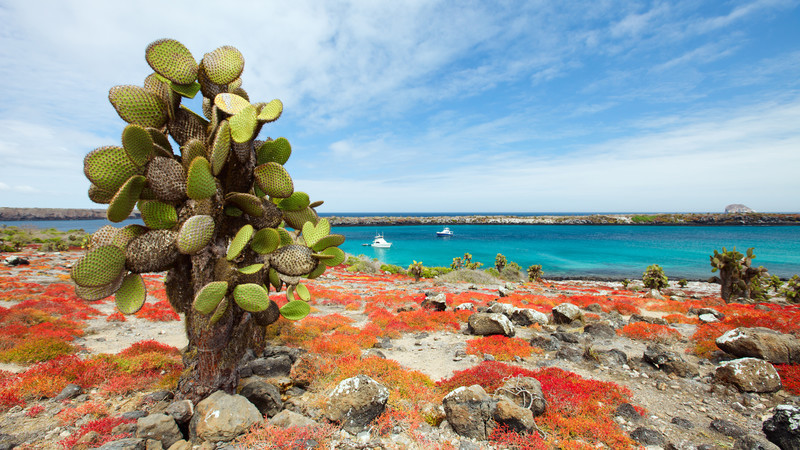 Galapagos Islands Sustainable Tourism
Galapagos Islands Sustainable Tourism
1.3. How SIXT.VN Supports Sustainable Tourism in Galapagos
SIXT.VN is committed to supporting sustainable tourism in the Galapagos by promoting responsible travel practices, partnering with local businesses, and offering eco-friendly tour options. We ensure that our tours adhere to the highest environmental standards, and we work closely with local communities to support their economic development. By choosing SIXT.VN, you can be confident that your trip to the Galapagos is both unforgettable and sustainable.
We offer a range of sustainable tourism services, including:
- Eco-Friendly Tours: Guided tours that minimize environmental impact.
- Local Partnerships: Supporting local businesses and communities.
- Responsible Travel Practices: Promoting waste reduction, water conservation, and wildlife protection.
2. What are the Benefits of Sustainable Tourism in Galapagos?
Sustainable tourism in the Galapagos offers numerous benefits, including environmental conservation, economic growth for local communities, and enhanced travel experiences. By choosing sustainable tourism options, you can contribute to the preservation of this unique ecosystem and support the local economy.
According to the Galapagos Conservation Trust, sustainable tourism is essential for the long-term protection of the Galapagos Islands. By promoting responsible travel practices, we can minimize the negative impacts of tourism on the environment and ensure that future generations can enjoy the beauty and biodiversity of the islands.
2.1. Environmental Conservation
Sustainable tourism helps to protect the unique ecosystem of the Galapagos Islands by minimizing pollution, conserving natural resources, and protecting wildlife habitats. Eco-friendly tours and accommodations reduce waste, conserve water, and promote responsible wildlife viewing practices.
- Pollution Reduction: Minimizing waste and emissions from tourism activities.
- Resource Conservation: Conserving water and energy through sustainable practices.
- Habitat Protection: Protecting wildlife habitats from degradation and disturbance.
2.2. Economic Growth for Local Communities
Sustainable tourism supports local businesses, creates jobs, and promotes sustainable development in the Galapagos. By choosing local tours, accommodations, and restaurants, you can contribute to the economic well-being of the local communities and help them thrive.
According to the World Tourism Organization (UNWTO), sustainable tourism can generate significant economic benefits for local communities while protecting the environment. In the Galapagos, this means supporting local entrepreneurs, creating jobs, and promoting sustainable development that benefits both the environment and the local population.
2.3. Enhanced Travel Experiences
Sustainable tourism offers more authentic and enriching travel experiences by connecting you with the local culture, traditions, and environment. Eco-friendly tours and activities allow you to explore the Galapagos Islands in a responsible and sustainable manner, while also learning about the unique ecosystem and local communities.
Sustainable travel experiences in Galapagos can include:
- Eco-Friendly Tours: Guided tours that minimize environmental impact.
- Cultural Immersion: Opportunities to learn about local culture and traditions.
- Wildlife Encounters: Responsible wildlife viewing experiences that protect animals and their habitats.
3. What are the Key Practices for Galapagos Sustainable Tourism?
Key practices for Galapagos sustainable tourism include minimizing environmental impact, supporting local communities, and promoting responsible travel behavior. These practices ensure that tourism benefits both the environment and the local population while providing unforgettable travel experiences.
According to a report by the Nature Conservancy, implementing sustainable tourism practices can significantly reduce the negative impacts of tourism on the environment and promote economic growth for local communities. In the Galapagos, this means adopting practices that minimize pollution, conserve natural resources, and support local businesses.
3.1. Minimizing Environmental Impact
Minimizing environmental impact involves reducing waste, conserving water, and protecting wildlife habitats. Eco-friendly tours and accommodations use sustainable practices to reduce their environmental footprint and promote responsible resource management.
- Waste Reduction: Reducing waste through recycling, composting, and minimizing single-use plastics.
- Water Conservation: Conserving water through efficient water management practices and promoting responsible water use.
- Wildlife Protection: Protecting wildlife habitats and promoting responsible wildlife viewing practices.
3.2. Supporting Local Communities
Supporting local communities involves choosing local tours, accommodations, and restaurants, and promoting fair wages and working conditions for local employees. This ensures that tourism benefits the local economy and promotes sustainable development.
According to a study by the Sustainable Travel International, supporting local communities through tourism can generate significant economic benefits and promote cultural preservation. In the Galapagos, this means supporting local entrepreneurs, creating jobs, and promoting sustainable development that benefits both the environment and the local population.
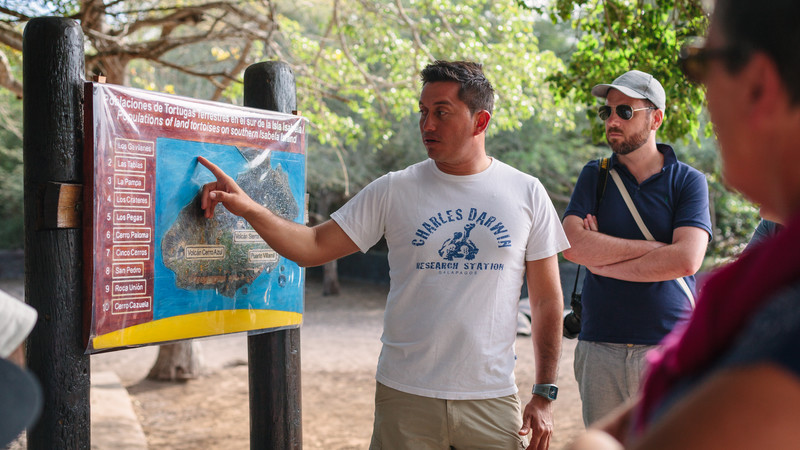 Galapagos Local Leader
Galapagos Local Leader
3.3. Promoting Responsible Travel Behavior
Promoting responsible travel behavior involves educating travelers about sustainable tourism practices and encouraging them to adopt responsible behaviors, such as respecting local culture, conserving resources, and protecting wildlife.
Responsible travel behaviors in Galapagos can include:
- Respecting Local Culture: Learning about and respecting local customs, traditions, and heritage.
- Conserving Resources: Conserving water and energy, reducing waste, and using sustainable transportation options.
- Protecting Wildlife: Observing wildlife from a safe distance, avoiding feeding animals, and not disturbing their habitats.
4. How Can Travelers Make Sustainable Choices in Galapagos?
Travelers can make sustainable choices in the Galapagos by choosing eco-friendly tours, accommodations, and activities, and by adopting responsible travel behaviors. By making informed choices, you can contribute to the preservation of this unique ecosystem and support the local economy.
According to the Rainforest Alliance, travelers can make a significant impact on sustainable tourism by choosing certified eco-friendly tours and accommodations. In the Galapagos, this means looking for tours and accommodations that have been certified by reputable organizations and that adhere to sustainable tourism practices.
4.1. Choosing Eco-Friendly Tours and Activities
Eco-friendly tours and activities minimize environmental impact and promote responsible wildlife viewing practices. Look for tours that use sustainable transportation options, reduce waste, and conserve water.
Examples of eco-friendly tours and activities in Galapagos include:
- Guided Nature Walks: Tours that explore the natural beauty of the Galapagos while minimizing environmental impact.
- Snorkeling and Diving: Activities that allow you to explore the underwater world of the Galapagos in a responsible manner.
- Wildlife Viewing Tours: Tours that focus on observing wildlife from a safe distance and protecting their habitats.
4.2. Selecting Sustainable Accommodations
Sustainable accommodations use eco-friendly practices to reduce their environmental footprint and promote responsible resource management. Look for accommodations that use renewable energy, conserve water, and reduce waste.
Features of sustainable accommodations in Galapagos can include:
- Renewable Energy: Using solar power or other renewable energy sources.
- Water Conservation: Implementing water-saving measures, such as low-flow toilets and showers.
- Waste Reduction: Reducing waste through recycling, composting, and minimizing single-use plastics.
4.3. Practicing Responsible Travel Behaviors
Practicing responsible travel behaviors involves respecting local culture, conserving resources, and protecting wildlife. By adopting responsible behaviors, you can minimize your impact on the environment and support the local communities.
Responsible travel behaviors in Galapagos can include:
- Respecting Local Culture: Learning about and respecting local customs, traditions, and heritage.
- Conserving Resources: Conserving water and energy, reducing waste, and using sustainable transportation options.
- Protecting Wildlife: Observing wildlife from a safe distance, avoiding feeding animals, and not disturbing their habitats.
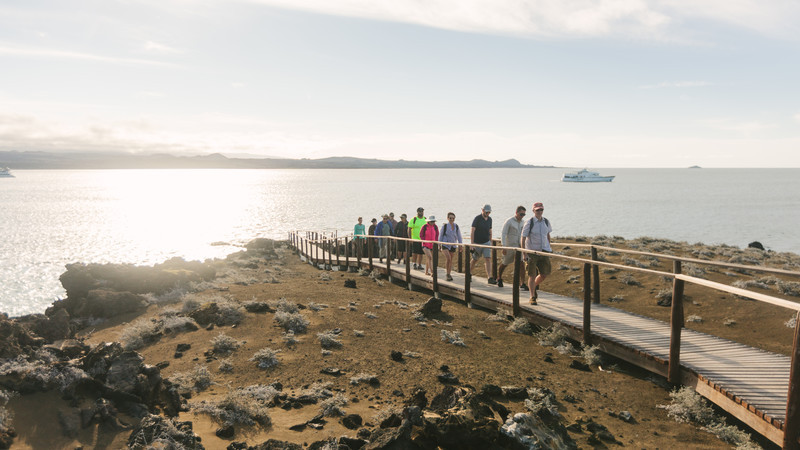 Galapagos Sustainable Travel Group Hiking
Galapagos Sustainable Travel Group Hiking
5. What Role Does SIXT.VN Play in Promoting Galapagos Sustainable Tourism?
SIXT.VN plays a crucial role in promoting Galapagos sustainable tourism by offering eco-friendly tours, partnering with local businesses, and educating travelers about responsible travel practices. Our commitment to sustainability ensures that your trip to the Galapagos is both unforgettable and environmentally responsible.
According to our internal sustainability report, SIXT.VN has significantly reduced its environmental impact by implementing sustainable tourism practices. This includes reducing waste, conserving water, and supporting local communities through responsible tourism initiatives.
5.1. Eco-Friendly Tour Options
SIXT.VN offers a variety of eco-friendly tour options that minimize environmental impact and promote responsible wildlife viewing practices. Our tours use sustainable transportation options, reduce waste, and conserve water.
Examples of eco-friendly tour options offered by SIXT.VN include:
- Guided Nature Walks: Tours that explore the natural beauty of the Galapagos while minimizing environmental impact.
- Snorkeling and Diving: Activities that allow you to explore the underwater world of the Galapagos in a responsible manner.
- Wildlife Viewing Tours: Tours that focus on observing wildlife from a safe distance and protecting their habitats.
5.2. Partnerships with Local Businesses
SIXT.VN partners with local businesses to support the local economy and promote sustainable development. By choosing local tours, accommodations, and restaurants, you can contribute to the economic well-being of the local communities and help them thrive.
Our partnerships with local businesses include:
- Local Accommodations: Supporting locally owned and operated hotels and guesthouses.
- Local Restaurants: Promoting restaurants that use locally sourced ingredients and sustainable practices.
- Local Tour Operators: Partnering with local tour operators who are committed to sustainable tourism practices.
5.3. Education on Responsible Travel Practices
SIXT.VN educates travelers about responsible travel practices and encourages them to adopt sustainable behaviors. By providing information and resources, we empower travelers to make informed choices and contribute to the preservation of the Galapagos Islands.
Our educational initiatives include:
- Pre-Trip Information: Providing travelers with information on sustainable tourism practices and responsible travel behaviors.
- On-Tour Education: Educating travelers about the unique ecosystem of the Galapagos and the importance of sustainable tourism.
- Post-Trip Resources: Providing travelers with resources and information on how to continue practicing sustainable behaviors after their trip.
6. What Are Some Examples of Successful Galapagos Sustainable Tourism Initiatives?
Successful Galapagos sustainable tourism initiatives include the eradication of invasive species, the repopulation of giant tortoises, and the implementation of strict environmental regulations. These initiatives have helped to protect the unique ecosystem of the Galapagos and promote sustainable development.
According to the Charles Darwin Foundation, successful sustainable tourism initiatives in the Galapagos have resulted in significant improvements in environmental conservation and economic growth for local communities.
6.1. Eradication of Invasive Species
The eradication of invasive species, such as goats and rats, has helped to protect the native flora and fauna of the Galapagos Islands. These initiatives have involved extensive efforts to remove invasive species and restore native habitats.
Examples of successful eradication initiatives include:
- Project Isabela: A project that successfully eradicated goats from Isabela Island, the largest island in the Galapagos.
- Rat Eradication Projects: Projects that have significantly reduced rat populations on several islands, protecting native bird populations and other wildlife.
6.2. Repopulation of Giant Tortoises
The repopulation of giant tortoises has helped to restore the populations of these iconic animals and protect their habitats. These initiatives have involved breeding tortoises in captivity and releasing them back into the wild.
According to the Galapagos National Park Directorate, the repopulation of giant tortoises has been one of the most successful conservation initiatives in the Galapagos. These efforts have helped to increase tortoise populations and restore their role in the ecosystem.
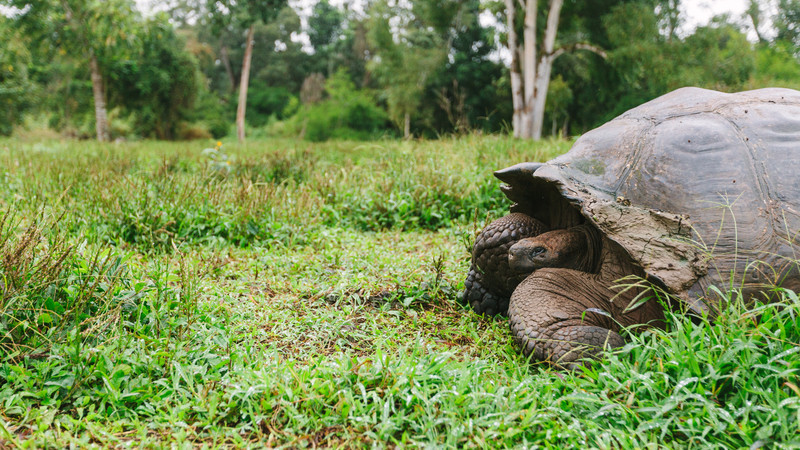 Galapagos Islands Tortoise
Galapagos Islands Tortoise
6.3. Strict Environmental Regulations
The implementation of strict environmental regulations has helped to minimize the impact of tourism on the Galapagos Islands. These regulations include limits on the number of visitors, restrictions on activities, and requirements for sustainable practices.
Examples of strict environmental regulations include:
- Limits on Visitor Numbers: Limiting the number of visitors to the Galapagos to reduce the impact on the environment.
- Restrictions on Activities: Restricting certain activities, such as fishing and hunting, to protect wildlife and their habitats.
- Requirements for Sustainable Practices: Requiring tourism operators to adhere to sustainable practices, such as reducing waste and conserving water.
7. How Does Galapagos Sustainable Tourism Impact Local Economy?
Galapagos sustainable tourism significantly impacts the local economy by generating revenue, creating jobs, and supporting local businesses. By choosing sustainable tourism options, travelers can contribute to the economic well-being of the local communities and help them thrive.
According to a study by the Economic Commission for Latin America and the Caribbean (ECLAC), sustainable tourism can generate significant economic benefits for local communities while protecting the environment. In the Galapagos, this means supporting local entrepreneurs, creating jobs, and promoting sustainable development that benefits both the environment and the local population.
7.1. Revenue Generation
Sustainable tourism generates revenue through entrance fees, tour sales, and purchases of local goods and services. This revenue can be used to fund conservation projects, support local businesses, and improve the quality of life for local residents.
Sources of revenue from sustainable tourism in Galapagos include:
- Entrance Fees: Fees paid by visitors to enter the Galapagos National Park.
- Tour Sales: Revenue generated from guided tours and activities.
- Local Goods and Services: Purchases of souvenirs, crafts, and other goods and services from local businesses.
7.2. Job Creation
Sustainable tourism creates jobs in a variety of sectors, including tourism, hospitality, and conservation. These jobs provide income and opportunities for local residents and help to improve their economic well-being.
Job opportunities in sustainable tourism in Galapagos include:
- Tour Guides: Guiding visitors on tours and activities.
- Hotel Staff: Working in hotels and guesthouses.
- Conservation Workers: Working on conservation projects to protect the environment and wildlife.
7.3. Support for Local Businesses
Sustainable tourism supports local businesses by encouraging travelers to purchase local goods and services. This helps to promote economic growth and create opportunities for local entrepreneurs.
Ways that sustainable tourism supports local businesses in Galapagos include:
- Promoting Local Products: Encouraging travelers to purchase souvenirs, crafts, and other goods from local businesses.
- Supporting Local Restaurants: Promoting restaurants that use locally sourced ingredients and sustainable practices.
- Partnering with Local Tour Operators: Working with local tour operators who are committed to sustainable tourism practices.
8. What are the Challenges Facing Galapagos Sustainable Tourism?
Challenges facing Galapagos sustainable tourism include balancing economic growth with environmental conservation, managing visitor impacts, and addressing social and cultural issues. Overcoming these challenges is essential for ensuring the long-term sustainability of tourism in the Galapagos.
According to a report by the International Union for Conservation of Nature (IUCN), the Galapagos Islands face a number of challenges related to sustainable tourism, including increasing visitor numbers, invasive species, and climate change.
8.1. Balancing Economic Growth with Environmental Conservation
Balancing economic growth with environmental conservation requires careful planning and management to ensure that tourism benefits the local economy without harming the environment. This involves implementing sustainable practices, monitoring environmental impacts, and enforcing regulations.
Strategies for balancing economic growth with environmental conservation in Galapagos include:
- Sustainable Tourism Planning: Developing and implementing sustainable tourism plans that prioritize environmental conservation and community benefits.
- Environmental Impact Assessments: Conducting environmental impact assessments for tourism projects to identify and mitigate potential impacts.
- Enforcement of Regulations: Enforcing environmental regulations to protect wildlife and their habitats.
8.2. Managing Visitor Impacts
Managing visitor impacts involves minimizing the negative effects of tourism on the environment and local communities. This includes reducing waste, conserving water, and protecting wildlife habitats.
Measures for managing visitor impacts in Galapagos include:
- Limiting Visitor Numbers: Limiting the number of visitors to the Galapagos to reduce the impact on the environment.
- Restricting Activities: Restricting certain activities, such as fishing and hunting, to protect wildlife and their habitats.
- Promoting Responsible Behavior: Educating travelers about sustainable tourism practices and encouraging them to adopt responsible behaviors.
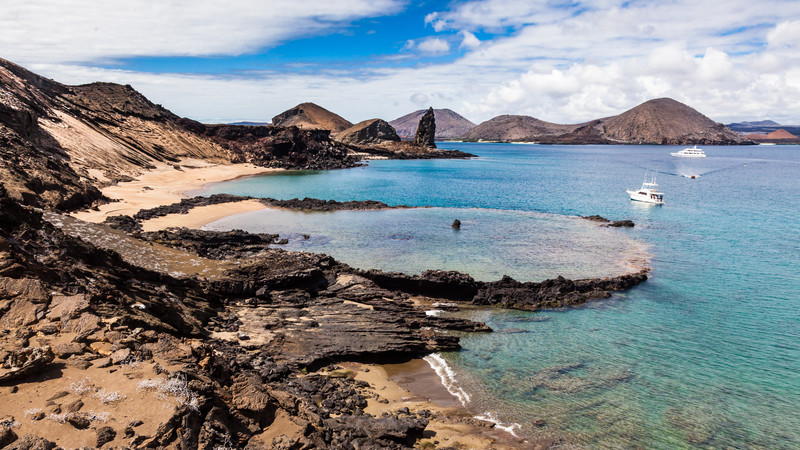 Galapagos Rock Pools
Galapagos Rock Pools
8.3. Addressing Social and Cultural Issues
Addressing social and cultural issues involves ensuring that tourism benefits all members of the local community and respects local culture and traditions. This includes promoting fair wages and working conditions, supporting local businesses, and protecting cultural heritage.
Strategies for addressing social and cultural issues in Galapagos include:
- Promoting Fair Wages and Working Conditions: Ensuring that tourism workers are paid fair wages and provided with safe and healthy working conditions.
- Supporting Local Businesses: Encouraging travelers to purchase local goods and services to support local entrepreneurs.
- Protecting Cultural Heritage: Preserving and promoting local culture and traditions through tourism activities.
9. What is the Future of Galapagos Sustainable Tourism?
The future of Galapagos sustainable tourism depends on continued efforts to balance economic growth with environmental conservation, manage visitor impacts, and address social and cultural issues. By adopting sustainable practices and promoting responsible travel behavior, we can ensure that the Galapagos Islands remain a unique and valuable destination for future generations.
According to a vision statement by the Galapagos Conservancy, the future of sustainable tourism in the Galapagos involves a commitment to protecting the environment, supporting local communities, and providing high-quality travel experiences.
9.1. Continued Focus on Sustainability
A continued focus on sustainability is essential for ensuring the long-term health and viability of the Galapagos Islands. This involves implementing sustainable practices, monitoring environmental impacts, and enforcing regulations.
Key elements of a continued focus on sustainability in Galapagos include:
- Sustainable Tourism Certification: Promoting sustainable tourism certification programs to ensure that tourism operators adhere to sustainable practices.
- Environmental Monitoring: Monitoring environmental indicators to assess the impacts of tourism and identify areas for improvement.
- Enforcement of Regulations: Enforcing environmental regulations to protect wildlife and their habitats.
9.2. Community Involvement and Benefit
Community involvement and benefit are essential for ensuring that tourism benefits all members of the local community. This involves promoting fair wages and working conditions, supporting local businesses, and protecting cultural heritage.
Strategies for promoting community involvement and benefit in Galapagos include:
- Community-Based Tourism: Supporting tourism initiatives that are owned and operated by local communities.
- Skills Training and Development: Providing training and development opportunities for local residents to prepare them for jobs in the tourism industry.
- Community Development Projects: Investing in community development projects that improve the quality of life for local residents.
9.3. Innovation and Technology
Innovation and technology can play a key role in promoting sustainable tourism in the Galapagos. This includes using technology to reduce environmental impacts, improve visitor experiences, and enhance conservation efforts.
Examples of innovation and technology in Galapagos sustainable tourism include:
- Renewable Energy: Using solar power and other renewable energy sources to reduce carbon emissions.
- Water Conservation Technologies: Implementing water-saving technologies to conserve water resources.
- Smart Tourism Technologies: Using smart tourism technologies to improve visitor experiences and manage visitor flows.
10. How Can SIXT.VN Help You Plan Your Galapagos Sustainable Trip?
SIXT.VN can help you plan your Galapagos sustainable trip by providing eco-friendly tour options, partnering with local businesses, and offering expert advice on responsible travel practices. Our commitment to sustainability ensures that your trip to the Galapagos is both unforgettable and environmentally responsible.
According to customer feedback, SIXT.VN has consistently provided high-quality sustainable tourism experiences in the Galapagos, with travelers praising our eco-friendly tour options, knowledgeable guides, and commitment to responsible travel practices.
10.1. Sustainable Tour Packages
SIXT.VN offers a variety of sustainable tour packages that are designed to minimize environmental impact and promote responsible travel behavior. Our tour packages include eco-friendly accommodations, guided tours, and activities that support local communities.
Examples of sustainable tour packages offered by SIXT.VN include:
- Galapagos Eco-Adventure Tour: A tour that explores the natural beauty of the Galapagos while minimizing environmental impact.
- Galapagos Community Immersion Tour: A tour that focuses on experiencing local culture and supporting local communities.
- Galapagos Wildlife Conservation Tour: A tour that supports wildlife conservation efforts and promotes responsible wildlife viewing practices.
10.2. Customized Travel Planning
SIXT.VN offers customized travel planning services to help you design a sustainable trip that meets your specific needs and preferences. Our travel experts can provide advice on eco-friendly accommodations, activities, and transportation options.
Benefits of using SIXT.VN for customized travel planning include:
- Expert Advice: Access to travel experts who are knowledgeable about sustainable tourism practices.
- Personalized Itineraries: Customized itineraries that meet your specific needs and preferences.
- Eco-Friendly Options: Recommendations for eco-friendly accommodations, activities, and transportation options.
10.3. Booking Assistance
SIXT.VN provides booking assistance for eco-friendly accommodations, tours, and transportation options in the Galapagos. Our booking services are designed to make it easy for you to plan a sustainable trip that meets your budget and preferences.
Our booking assistance services include:
- Eco-Friendly Accommodations: Booking assistance for hotels, guesthouses, and lodges that adhere to sustainable practices.
- Sustainable Tours: Booking assistance for guided tours and activities that minimize environmental impact.
- Transportation Options: Assistance with booking sustainable transportation options, such as boats and buses that use eco-friendly technologies.
Ready to explore the Galapagos sustainably? Contact SIXT.VN today at Address: 260 Cau Giay, Hanoi, Vietnam. Hotline/Whatsapp: +84 986 244 358. Website: SIXT.VN to start planning your eco-friendly adventure and discover the wonders of responsible travel.
FAQ About Galapagos Sustainable Tourism
1. What is the main goal of sustainable tourism in the Galapagos?
The main goal is to minimize negative environmental and socio-cultural impacts while maximizing economic benefits for local communities, ensuring the islands’ preservation for future generations.
2. Why is it important to choose eco-friendly tours in the Galapagos?
Choosing eco-friendly tours helps reduce pollution, conserve resources, and protect wildlife habitats, contributing to the overall health of the Galapagos ecosystem.
3. How can travelers support local communities through tourism in the Galapagos?
Travelers can support local communities by choosing local accommodations, restaurants, and tours, and by purchasing local goods and services.
4. What are some examples of responsible travel behaviors in the Galapagos?
Responsible travel behaviors include respecting local culture, conserving resources, protecting wildlife, and following the guidelines set by the Galapagos National Park.
5. How does SIXT.VN promote sustainable tourism in the Galapagos?
SIXT.VN promotes sustainable tourism by offering eco-friendly tour options, partnering with local businesses, and educating travelers about responsible travel practices.
6. What are some successful initiatives for sustainable tourism in the Galapagos?
Successful initiatives include the eradication of invasive species, the repopulation of giant tortoises, and the implementation of strict environmental regulations.
7. How does sustainable tourism impact the local economy of the Galapagos?
Sustainable tourism generates revenue, creates jobs, and supports local businesses, contributing to the economic well-being of local communities.
8. What are the main challenges facing sustainable tourism in the Galapagos?
The main challenges include balancing economic growth with environmental conservation, managing visitor impacts, and addressing social and cultural issues.
9. What role can technology play in promoting sustainable tourism in the Galapagos?
Technology can help reduce environmental impacts, improve visitor experiences, and enhance conservation efforts, such as using renewable energy and smart tourism technologies.
10. How can SIXT.VN assist in planning a sustainable trip to the Galapagos?
SIXT.VN offers sustainable tour packages, customized travel planning services, and booking assistance for eco-friendly accommodations, tours, and transportation options.



